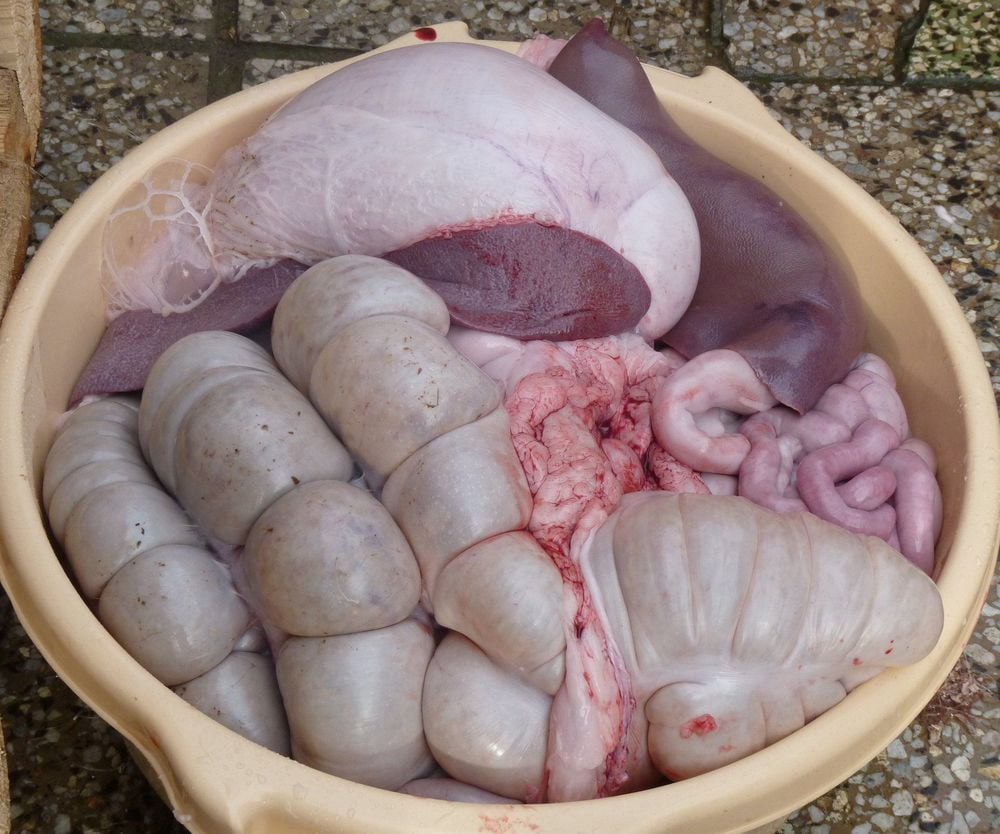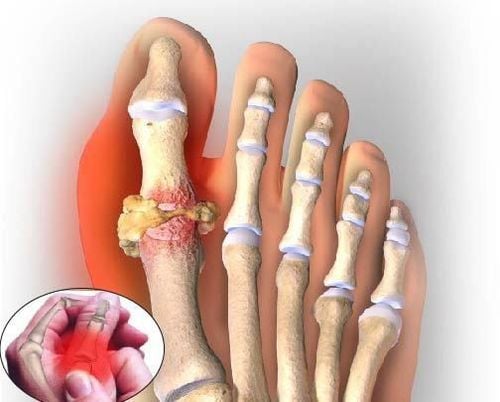This is an automatically translated article.
Organ meats were once a treasured and cherished food source. However, now the tradition of eating animal organs has fallen out of favor. In fact, many people who have never eaten organ meat may find it uncomfortable. But, organ meats are actually quite nutritious.
1. Learn about organ meats
Organ meats, sometimes called animal offal, include the organs of animals that humans use as food for processing and consumption. The animals most commonly eaten offal by humans are: Cows, pigs, sheep, goats, chickens and ducks.
Today, most animals are raised lean towards the lean, so organ meat is often overlooked. And most meats are usually consumed as steaks, thighs, or minced.
Organ meats, such as brains, intestines and even testicles. In fact, organ meats are highly prized. In addition, it can also add organ meats to the diet, because they contain many nutrients, such as: vitamin B12, folate, iron and excellent protein.
2. Organ meats
Some popular organ meats include:
Liver: Detoxification Organ: The liver provides the nutritional source of organ meats and is sometimes referred to as “nature's multivitamin”. Tongue: The tongue is actually a muscle: It's the tender and delicious flesh due to its high fat content. Heart: Has the role of pumping blood throughout the body, contains a lot of lean parts that bring a sense of deliciousness. Kidneys: Similar to humans, mammals also have 2 kidneys. The kidneys filter waste and toxins out of the blood. Brain: The brain is known to be a delicacy in many cultures and it is a rich source of omega-3 fatty acids. Spleen: Made from the thymus and pancreas. Beef stomach: Most bacon is just from cattle and can have a very chewy texture.

Thịt nội tạng, đôi khi được gọi nội tạng động vật, bao gồm các cơ quan của động vật mà con người sử dụng làm thực phẩm
3. Nutritional composition of organ meat
The nutritional composition of organ meats may vary, depending on the animal source and the type of organ. But most of these meats are extremely nutritious. Organ meats are particularly rich in B vitamins, such as: Vitamin B12 and folate, minerals such as iron, magnesium, selenium and zinc, and important fat-soluble vitamins such as vitamins A, D, E and K. Visceral fat also has the ability to dissolve fat-soluble vitamins for absorption into the body.
Organ meats are a pretty rich source of protein, including all nine essential amino acids your body needs to function properly.
In 100 grams of cooked beef liver provides: 175 Kcal, 27 grams of protein, 1.386% RDI vitamin B12, 730%RDI copper, 522%RDI vitamin A, 201% RDI Riboflavin, Niacin: 87% RDI, Vitamin B6: 51 % RDI, Selenium: 47% RDI, Zinc: 35% RDI, Iron: 34% RDI.
4. Benefits of organ meat in the diet
Supply Iron: Meat contains heme iron, which is highly bioavailable, so it is better absorbed by the body than non-heme iron from plant foods. Make you feel fuller for longer: Many studies have shown that a high-protein diet can reduce appetite and increase feelings of fullness. It can also promote weight loss by increasing metabolic rate. Maintain Body Mass: Organ meats are a great source of high-quality protein, which is important for building and maintaining muscle mass. Great Source of Choline: Organ meats are one of the world's best sources of choline, an essential nutrient for brain, muscle, and liver health.

Thành phần dinh dưỡng của các loại thịt nội tạng có thể khác nhau
5. Some problems when using organ meat
5.1. Does organ meat raise cholesterol?
Organ meats are high in cholesterol, regardless of animal origin. In 100 grams of beef brain contains 1.033% of the RDI for cholesterol, while the kidneys and liver have 239% and 127% respectively.
In some people, cholesterol is often associated with clogged arteries, or heart-related diseases. However, cholesterol is produced by the body's liver, which regulates the body's production of cholesterol according to the amount of cholesterol in the daily diet.
When eating organ meats that are high in cholesterol, the liver responds by producing less. Therefore, cholesterol-rich foods have only a small impact on the body's total blood cholesterol levels.
Furthermore, dietary cholesterol has a small, if any, effect on cardiovascular disease risk.
A meta-analysis of 40 prospective studies on dietary cholesterol consumption and health risk. This analysis concluded that dietary cholesterol was not significantly associated with heart disease or stroke in healthy adults.
However, there are still some people who make up about 30% of the population who are sensitive to dietary cholesterol. For these subjects, the consumption of cholesterol-rich foods can increase total cholesterol.
5.2. Who should limit the use of organ meat There are not many restrictions when incorporating organ meat into the daily diet. However, some people may be susceptible to the effects of high intake and need to limit their consumption of this meat.
People with gout need to limit their intake of organs Gout is characteristic of common arthritis. It can be caused by high levels of uric acid in the blood, which causes joints to become swollen and tender. Purines in the diet form uric acid in the body. Organ meats, especially high in purines, should be used in moderation to avoid increased uric acid levels in the body through the daily diet.
Pregnant women should monitor their intake: Organ meats are a rich source of vitamin A, especially liver. During pregnancy, the growth and development of the fetus need extra vitamin A. However, the National Institutes of Health recommends getting more than 10,000 IU of vitamin A from food per day, because Excessive absorption has been linked to serious birth defects and abnormalities, including: Heart, spinal cord and neural tube defects, eye, ear and nose abnormalities, gastrointestinal tract and kidney abnormalities. Several studies conducted in pregnant mothers showed that mothers who consumed more than 10,000 IU of vitamin A per day from food had a higher risk of having a baby with birth defects than mothers who consumed 5,000 IU or less. about 80% per day. Therefore, it is important to monitor your organ meat intake during pregnancy, especially if you are taking supplements containing vitamin A. Mad cow disease Mad cow disease or bovine spongiform encephalopathy ( BSE), affects the brain and spinal cord of cattle. The disease can be transmitted to humans through proteins called prions, which are found in contaminated brain and spinal cord. It causes a rare encephalopathy, Creutzfeldt-New Variant Jakob (vCJD).
Although, the number of BSE cases has decreased significantly since the feeding ban was introduced in 1996. This ban makes it illegal to add any meat and livestock to the forage. legal.

Những người bị bệnh gút cần hạn chế ăn nội tạng
6. The taste of organ meats
Organ meats are becoming more and more popular in high-end restaurants due to their bold and unique flavors. Since it can take some time to develop a preference for organ meats, it's best to start with softer flavored organ meats like tongue and heart.
You can also try making organ meats by grinding the liver and kidneys and combining them with minced beef or pork in dishes like Bolognese.
Alternatively, these meats can be added to cooked casseroles with other meats such as lamb. This can help you gradually enjoy stronger flavors.
Organ meats are quite rich with a variety of vitamins and minerals that are hard to get from other foods. If you like to eat meat, you should replace some of the muscle meat with organ meat. Not only does it give you some extra nutrition, but it's also easy to use and good for the environment.
Please dial HOTLINE for more information or register for an appointment HERE. Download MyVinmec app to make appointments faster and to manage your bookings easily.
Reference sources: healthline.com, webmd.com












